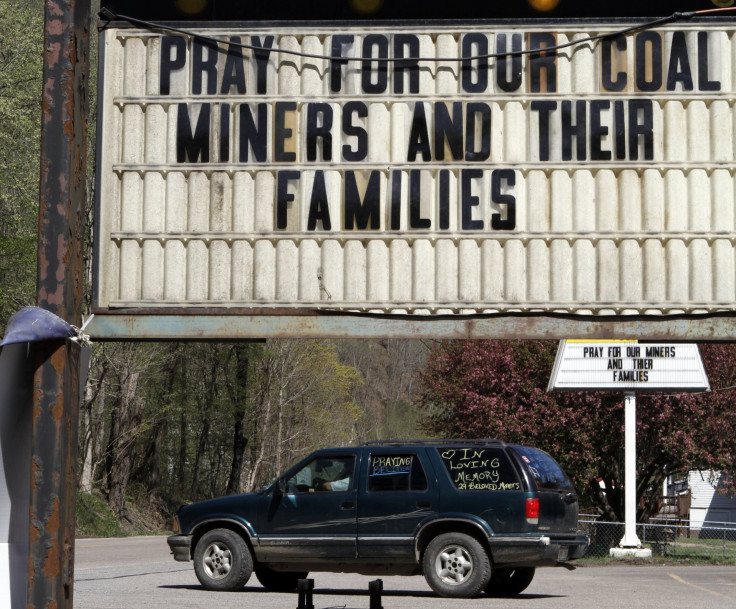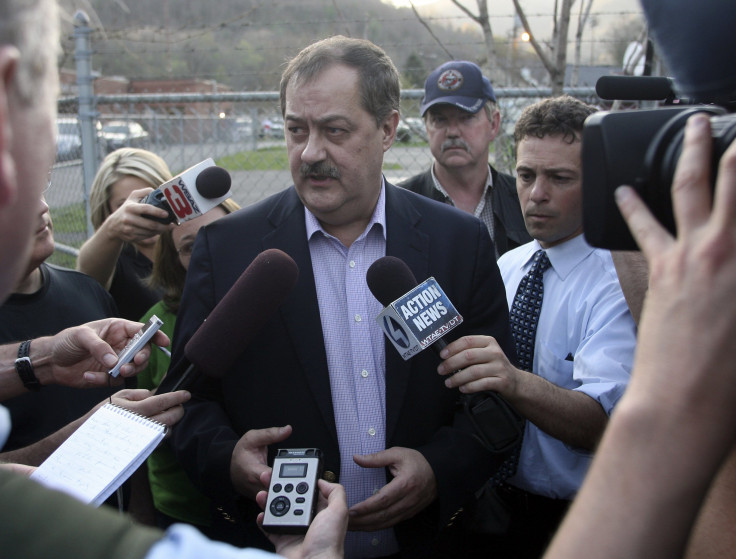Don Blankenship Trial: Massey Energy CEO Faces Rare Criminal Prosecution For Workplace Safety Issues

On a late summer day in 2007, a 69-acre section of a coal mine in central Utah caved in and crushed 6 workers to death. The following year, dust buildup at a Georgia sugar refinery triggered an explosion that killed 14 people. In April 2010, an explosion rocked the Upper Big Branch coal mine in southern West Virginia, killing 29 workers. In each case, federal regulators deemed employers responsible for what were easily preventable workplace disasters; only in the latter has a corporate executive faced criminal prosecution.
In a trial that kicked off earlier this month, former Massey Energy CEO Don Blankenship faces three felony counts that carry a combined maximum sentence of 30 years. The charges are closely tied to the disaster at Upper Big Branch. Meanwhile, executives for the other companies -- Murray Energy and Imperial Sugar -- walk free. In fact, Blankenship is the first CEO of a major corporation to face criminal prosecution over workplace safety issues -- a fate that's historically been reserved for only a handful of small business owners.
That the coal baron has no predecessors of comparable stature is the product of a complex mix: weak regulations, tough-to-meet evidentiary standards, apparent disinterest from prosecutors and finely-honed shielding practices in the corporate world.
“We know there is criminal negligence happening in workplaces every day,” says Peter Dooley, a health and safety consultant for the non-profit National Council for Occupational Safety and Health. “Only nobody is held accountable.”
More Expensive To Mistreat A Burro Than Kill A Worker
Workplace safety laws prescribe criminal charges under a narrow set of circumstances: Employers must willfully violate safety standards, give advanced notice of inspections or make false statements. Then, the enforcement agencies -- in most cases, the Occupational Safety and Health Administration (OSHA), which covers most private sector workers and the Mine Safety and Health Administration (MSHA) which covers mining workers -- have to recommend criminal prosecution to the Justice Department. The maximum penalty for these sorts of violations is a misdemeanor.

Dooley says the relatively low reward dissuades federal prosecutors from pursuing cases. As worker safety advocates like to point out, the penalty for mistreating a wild burro on federal land is higher than OSHA's maximum sentence for killing a worker.
There’s also a high bar for holding individuals personally responsible for fatalities on the job, as opposed to their employers at large.
“For criminal law convictions, you have to prove an individual’s personal culpability beyond a reasonable doubt, so that’s a tough standard,” says Jennifer Rodgers, executive director of the Center for the Advancement of Public Integrity at Columbia Law School and a former federal prosecutor in the Southern District of New York.
Since 2008, only 11 individuals have faced criminal prosecution for violations under occupational health and safety statutes, according to data provided to International Business Times. Mine safety regulators were unable to immediately provide the equivalent data.
When it comes to CEOs, Rodgers says, “you have to be able to prove that the person is culpable, that it’s the person at the head of the company, and it’s not the fault of middle managers or supervisors who are actually at the site.”
But she also says the low penalties prescribed by workplace safety regulations need not dissuade authorities from bringing cases against executives. Prosecutors have other tools at their disposal "that carry higher penalties."
Indeed, Blankenship himself isn’t on trial for violating mine safety rules per se. He’s being charged under general conspiracy statutes -- in effect, for defrauding the United States government. He faces two such felony counts: conspiracy to violate mining safety rules and conspiracy to block inspectors from carrying out their duties at the Upper Big Branch mine before the explosion. The other felony is for misleading financial regulators about his company’s safety record after the explosion.
“You have to have the right facts to fit within the statute but it’s pretty easy on a case when it’s regulated by the feds, like mining, to bring that conspiracy charge or an obstruction charge of stopping the government from enforcing those mining regulations,” says Rodgers.
Rena Steinzor, a law professor at the University of Maryland, says prosecutors “haven’t been creative enough” in taking such routes. “There’s no question that the [occupational health and safety] law is terribly weak, but there are other ways to prosecute these people.”
She says the prosecution of Blankenship clearly stems from the explosion, which caused long-standing frustrations with the company to boil over and demanded a response.
“Don Blankenship is the worst of the worst, he’s almost a caricature,” says Steinzor, author of Why Not Jail? Industrial Catastrophes, Corporate Malfeasance, and Government Inaction. “It’s just appalling what was going on there. It was going on for years and the government was sort of impotent. Everybody was watching, it was like a train wreck in slow motion.”
A Hands-On Management Style
What distinguishes Don Blankenship from other executives -- in coal and other industries -- is his hulking presence over the day-to-day grind of the business, says Patrick McGinley, a law professor at West Virginia University who participated in the independent investigation following the Upper Big Branch disaster.
According to the indictment, about a year before the disaster at Upper Big Branch, Blankenship personally requested and began to receive daily reports detailing his company’s violations of federal safety standards. He got frequent updates about specific mining activities, “routinely directing and making decisions on detailed matters of the mines’ everyday operations.” He also wrote notes to executives instructing them to cut corners on safety.
In one of them, according to the indictment, he criticized an executive for letting “MSHA run his mines.” Another note called on an executive to “run some coal. We’ll worry about ventilation or other issues at an appropriate time. Now is not the time.”
“Generally speaking, corporate CEOs are not micro-managing like this,” says McGinley. “There’s a lot of evidence here.”
Prosecutors have also called on coal miners to testify against Blankenship. Last week, a former miner at Upper Big Branch described “shocking” conditions at work, when she started in 2008. She said she and her co-workers were told to ignore a hazard-warning sign and climb into a dangerous, blocked-off section of the mine. She also described how, working as a dispatcher, managers told her to warn underground workers when inspectors arrived at the mine.
On Tuesday, jurors heard a recording of a phone call in which Blankenship aired concerns about the company’s vice president for safety Elizabeth Chamberlin. Massey Energy, he said, has “got to have someone [in that job] who actually understands that this game is about money.” He continued, “I mean, that’s the reason that we’re employed and that’s how we’re compensated, and we’ve got to get to the money aspects of this thing, rather than the social aspects.”

“Having hourly reports of what’s happening in individual mines sent to him, that’s a paper trail,” says Erik Loomis, a labor history professor at the University of Rhode Island. “And CEOs are supposed to be shielded from paper trails. Even when scandals do come out, CEOs are shielded from that -- it’s middle-management, it’s somebody down below.”
Loomis says many major corporations have adapted to new regulations by distancing high-ranking executives from operations on the shop floor -- or the mines and rigs. In part, the growing use of subcontractors reflects that concern by installing another degree of separation between decision-making executives and their day-to-day business.
“These modern shielding techniques are happening, in part, as the result of the rise of a regulatory state in the 1960s and 1970s, whether we’re talking about environmental stuff or workplace safety issues,” Loomis says. “In all of these cases, it’s a situation where the companies are trying to effectively respond to a growing demand for accountability by finding new ways to separate themselves from the production process.”
A ‘Wind Of Change’
Rena Steinzor, the law professor from Maryland, believes there’s a “wind of change” encouraging the criminal prosecution of corporate executives.
Steinzor points to the recent conviction of Stewart Parnell, the former peanut executive sentenced to 28 years in prison last month. Parnell was convicted for his role in a nationwide salmonella outbreak in 2008 and 2009 that killed nine people.
She also references a recent law in New York State that made so-called wage theft a criminal offense. That enabled arrests like the one this summer, when the owner of nine Papa John’s franchises in the Bronx pled guilty to not paying employees minimum wage or overtime.
Meanwhile, the revelations that Volkswagen systematically cheated on emissions standard tests have sparked calls to jail high-level executives. And earlier this month, Democratic Sens. Richard Blumenthal (D-Connecticut) and Bob Casey (D-Pennsylvania) reintroduced the so-called “Hide No Harm” bill that would make it a crime for a corporate official to “knowingly conceal information about a corporate action or product that poses the danger of death or serious physical injury to consumers or workers.”
Steinzor says the anger over the failure to prosecute high-level Wall Street executives has likely played a role in fueling the recent wave of corporate accountability initiatives.
For worker health and safety advocates like Peter Dooley, there’s no question what they’d like to see.
“If we had more criminal prosecutions, that would be an incredible incentive for businesses to be making better decisions about adopting worker health and safety programs and preventing fatalities,” says Dooley. “Absolutely.”
© Copyright IBTimes 2024. All rights reserved.




















